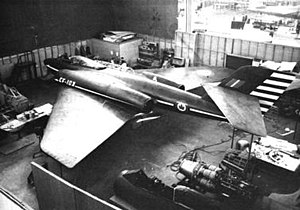Avro Canada CF-103
| CF-103 | |
|---|---|
 |
|
| CF-103 mock-up at the Avro company | |
| Role | Interceptor |
| Manufacturer | Avro Aircraft Limited (Canada) |
| Status | Cancelled December 1951 |
| Primary user | Royal Canadian Air Force (intended) |
| Number built | 0 |
| Developed from | Avro Canada CF-100 |
The Avro Canada CF-103 was a proposed Canadian interceptor, designed by Avro Canada in the early 1950s as a development, and possible replacement of the company's CF-100 Canuck, that was entering service at the time with the Royal Canadian Air Force (RCAF). Although intended to be capable of flying at transonic speeds, the CF-103 only proffered a moderate increase in performance and capability over the CF-100; subsequently, the aircraft never progressed beyond the mock-up stage.
Even before the prototype of the CF-100 had flown, Avro Canada was conducting studies of potential advanced variations of the aircraft, as the RCAF was seeking an interceptor with greater high-speed performance. Due to the perceived limitations of the CF-100's original "thick", straight wing, Chief Designer John Frost proposed a series of refinements that included a thinner swept wing. In December 1950, the Avro Aircraft Design Office decided to proceed with a redesign, primarily incorporating the early series CF-100 fuselage structure with a new swept wing and tail surfaces as part of the C-100S design study.
Frost considered the new design as an interim aircraft between the CF-100 and the more advanced C-104 project. The salient changes to the basic wing planform were in decreasing its chord and thickness, and adding a 42° sweep to the leading edge, creating a near-delta wing configuration. The tail surfaces were also swept back. One version that was considered featured two streamlined fuel tanks blended into the leading edge of the wings near the three/quarter position. Despite the use of more powerful engines, the redesign had very modest performance specifications, with a planned maximum diving speed of Mach 0.95, scarcely better than the placarded Mach 0.85 speed limit of the production CF-100 Mk 2 and Mk 3. Avro executives, recognizing that the company had already suffered due to the protracted development of the CF-100, determined that Frost's revised design would provide a "hedge" against the CF-100's failure to secure long-term contracts.
...
Wikipedia
